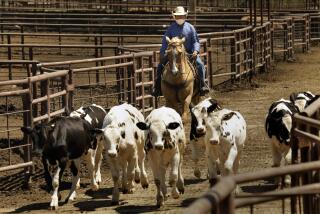Beef Consumption by Americans Declines From Record High Levels
Major changes are occurring in Americans’ meat-eating habits, and the continuing evolution provides little cause for celebration down on the cattle ranch, according to a beef industry-sponsored report.
Statistics compiled by the National Cattlemen’s Assn. reveal a virtually uninterrupted drop in per capita beef consumption since 1976.
In fact, preliminary figures for 1985 indicate that Americans now consume about 77 pounds of beef per person, an 18% decline since 1976’s record level of 94 pounds.
The group projects that by 1987, consumption of beef will decline even further to about 70 pounds per person, or to a level 25% below the 1976 high. The estimate is particularly surprising because of the millions of advertising dollars spent annually to promote hamburgers by the fast-food chains.
Oddly enough, the turn in beef’s fortune parallels a record increase in the consumption of all meats, both red and white, the association reports. This year, U. S. consumers are projected to eat about 225 pounds of meat, including beef, pork and poultry, compared with 204 pounds in 1975.
The sharp rise in overall animal protein consumption has been fueled by the poultry industry’s successful marketing to the health conscious and by the proliferation of highly processed chicken and turkey products, such as luncheon meats, frankfurters and fast-food offerings.
The cattlemen’s association soft-pedals the distressing figures by claiming that all beef raised in this country each year is consumed and that production dictates demand. Furthermore, the group states that the record consumption figures of the mid-1970s are inflated because more beef was rushed to market than usual as a means of stemming major financial losses in the cattle industry.
Temporary market conditions aside, the competition from the poultry industry is taking a financial toll on cattle ranchers that goes far beyond the victory in the health-image category. Chicken ranchers can bring their birds to market much faster than can their cattle-raising counterparts. This disparity in a declining market is one of several conditions that have placed about one-third of all cattle farms in “serious financial trouble,” the association states.
Finally, the group urges the food industry to develop more convenient and desirable beef products to stem any further deterioration in America’s “preferred meat.” One particularly sound suggestion is for food companies to introduce cuts where strips of fat are not as obvious and in need of trimming.
An Antibiotic Threat?--Another problem facing the meat industry’s image is the use of antibiotics in animal feed to promote growth and protect animals from harmful bacteria.
A potential problem arises because some of the drugs administered to livestock and poultry are also given to humans. Consequently, a number of scientists theorize that there is a possibility that some drug-resistant bacteria or virus may develop in the treated animals and then be transferred to humans when the meat enters the food supply.
Despite the fears, there had been few, if any, indications that a problem of this sort has surfaced until last year. In 1984, the Centers for Disease Control revealed that a salmonella outbreak was linked to an antibiotic-resistant bacteria in beef.
However, this seemingly precedent-setting federal study was taken to task recently by a critic of the super-bacteria theory.
“A new report from the American Council on Science & Health seems to fly in the face of mounting evidence that there is some danger to human health caused by regular . . . use of penicillin and tetracyclines in animal feed. Richard A. Greenberg, (the group’s) associate director, says considerable scientific doubt remains despite a (federal) study . . . that traced an outbreak of salmonellosis to beef fed chlortetracycline,” according an account of the study in Chemical & Engineering News.
The salmonellosis was more likely to have originated from those who came in physical contact with a dairy herd in the proximity of the outbreak, Greenberg was quoted as saying.
An Explosive Match--The proliferation of warehouse-style food and liquor stores has become a fact of life in the supermarket industry as food retailers attempt to attract consumers for a wide variety of household needs beyond just meat and produce.
However, the latest entry in this bulk approach to shopping has a somewhat different touch.
The debut of Expo Drug & Liquor Warehouse in Garden Grove combines two segments of the consumer products industry that is likely to set teetotalers reeling. The store’s 23,000 square feet are devoted primarily to pharmaceuticals and “name-brand liquor, beer and wine,” according to the Grocers Journal of California.
Other food items will be offered, but the teaming of beverage alcohol with prescription drugs is likely to be a first in the nation. The grocers journal admitted that the store’s format was “unique.”
More to Read
Sign up for Essential California
The most important California stories and recommendations in your inbox every morning.
You may occasionally receive promotional content from the Los Angeles Times.









